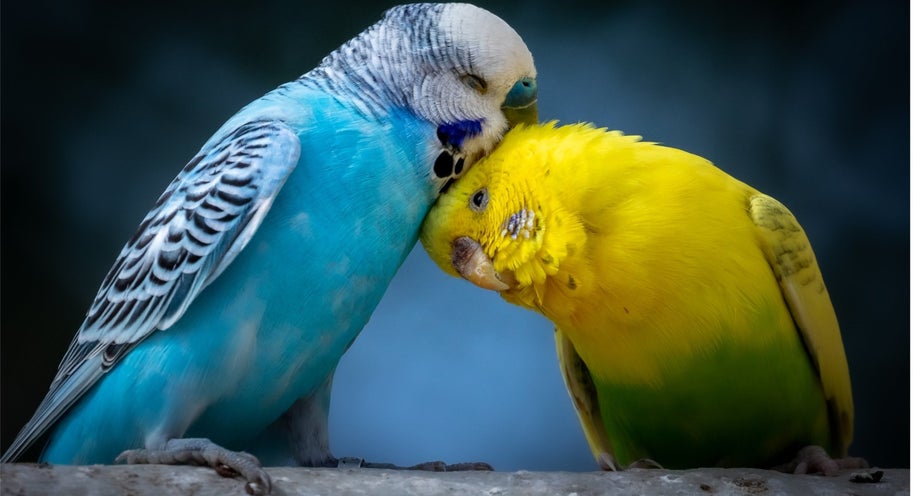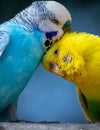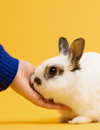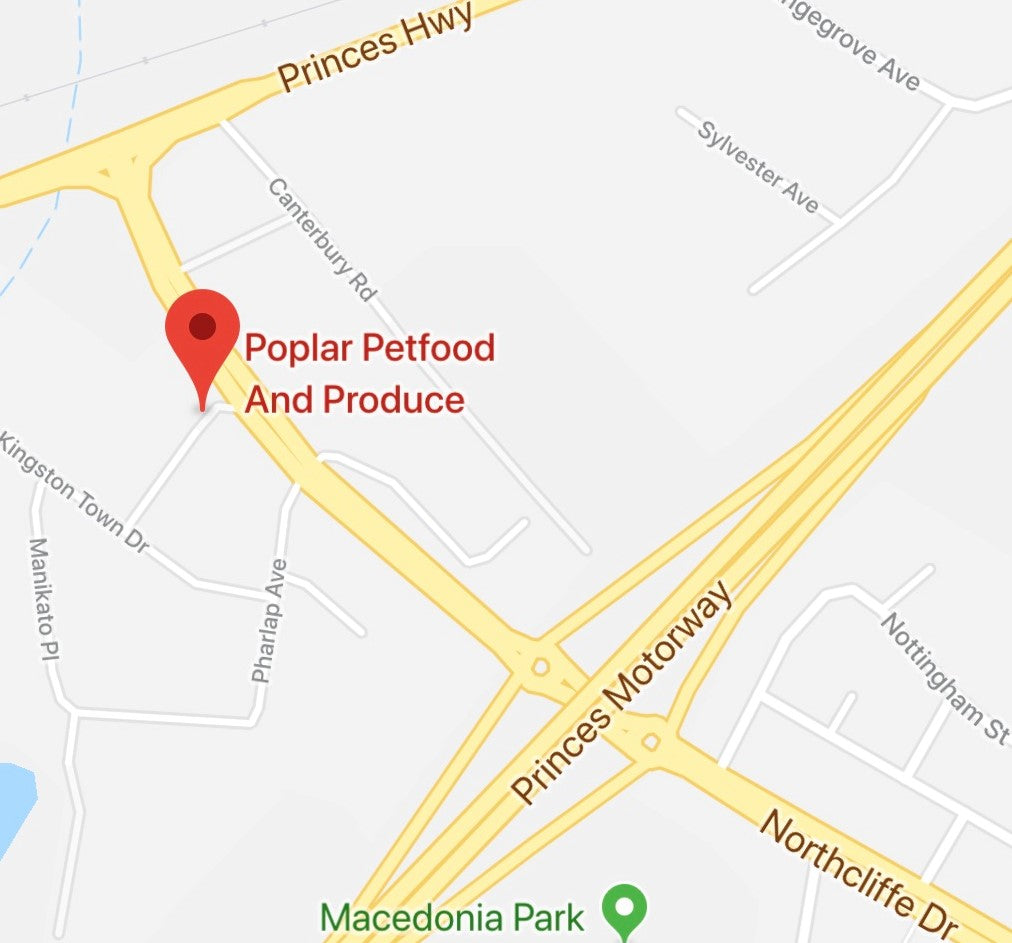
Budgies are the single most popular pet bird.
They are also known as a parakeet in other parts of the world including the USA.
Baby budgies can be easily identified as the feathering on top of their head has a series of bars that continue down to the cere. The cere is the fleshy are above the beak where the nostrils (nares) are located. When the bird reaches the age of 8-12 weeks the bars start to gradually malt out until eventually the top of the head is completely clear colour. Unfortunately it is not possible to guarantee the sex of the budgie at an early age but after the age of about 3 months old, the cere has turned blue for a cock bird or brown for a hen.
Your new bird will likely be handed to you in a small “pet box”. This is the best method of transportation, and ensures that your budgie will remain safe and protected until you are ready to install him in his new home. It is not advisable to transport birds in uncovered open cages.
Cages
Any cage recommended by our team will be suitable for your pet as we have the experience in the suitable housing of all pets. Any cage should be able to house some activity toys as well without cramping exercise space for your bird. Generally the larger the cage the better it is for exercising purposes.
Transferring your bird to their cage when you arrive home
Adopt the following procedure when letting your budgie out of the transport box and into his new cage. Firstly, position the cage in a room that has a relatively even temperature, away from draughts, and not too near a window as this may cause too much exposure to temperature variations. It should be also be placed in a position where it cannot be interfered with by small children and other pets. Ensure that the cage is set up complete with food and water and initially a small amount of seed should be sprinkled on the floor to ensure that the budgie has enough to eat while he is finding the seed containers.
Ensure the windows and doors are all closed, and then when everything is ready, gently let the budgie walk into their new cage. Do not attempt to force him in or tap the box…let him do it in his own time. At first he may be a bit bewildered, and perhaps even fly around wildly in the unfamiliar surroundings of his new cage. If he does not settle quickly, place a light cloth over the cage covering three sides to offer an extra sense of security.
Over excited children can stress your new budgie, so if children are present, be very conscious of their behaviour at this time. Your bird should be left alone on the first day to readjust. As he regains his confidence, he will begin to explore his new home. Very young birds may just sit on the perch or floor, and the seed scattered on the floor ensures that he finds enough to eat during this time. If after 24 hours, the baby bird has not moved, or is showing no sign of eating, contact your local vet for advice.
Feeding
Budgies are very easy birds to feed and all Just For Pets stores can supply a quality budgie mix consisting of a balanced fresh seed diet. Always ensure, that you purchase a mix that is similar to what the bird has been feeding on prior to you owning him. It is very important that seed and water containers are checked every day, as budgies ‘shuck’ the seeds they eat and leave the empty husks on the top of the seed dish. These shucks should be blown away thus revealing the uneaten seed below. Millet sprays can be provided in small quantities as treats, but not to excess as they can be fattening. Honey bells and seed bars and other treats may also be offered to provide a variation in diet. Another essential is good quality shell grit as this helps part of the budgies digestive system grind up the seed after it has been swallowed.
Cuttlefish and mineral blocks should also be offered, as these provide calcium, other minerals and trace elements that may be lacking in the seed diet. Small quantities of fresh green food may also be provided in the form of well rinsed pieces of fruit and/or vegetables. Always rinse this food as it is possible for residual toxic pesticides to remain on some produce.
Toys
Toys should not be introduced into your budgies cage while he adjusting to his new surroundings. They should be introduced gradually, starting with a small for example, and then perhaps a ladder before moving onto toys that provide environmental enrichment. Rather than fill the cage with toys, it is better to change the toys from time to time to offer variety for the bird. If your family are out at work every day, the best ‘toy’ could be another budgie, but ensure the cage is of suitable size to accommodate two. The little birds are very sociable by nature and welcome their own species for company.
Taming and teaching your Budgie to talk
To hand time a pet budgie takes time and patience. If your new budgie was not purchased already tamed and it is a young bird, you can hand tame it yourself. Initially, all you should do is position your chair right next to the cage during the evening until your regular presence has created a confidence in him. The next step in taming is to place your hand inside the cage and talk quietly all the time until he becomes accustomed to its presence and ceases to fly around the cage. Eventually he will walk across your palm and will even perch on your finger.
Before bringing a budgie out of its cage on your hand, make sure that all doors are shut, fireplaces guarded and windows are closed and curtained. All ornaments that might be knocked down should be removed. Initially it is advisable to stop your pet from flying off by carefully placing a thumb gently over his foot. Leave him on your finger for less than one minute then return him to the cage, repeating on successive evenings until he is used to the procedure. Care must be taken not to startle the bird. If he should start to fly about nervously, leave him alone until he settles then gently approach and try and pick him up.
Do not attempt to chase him or weeks of confidence will be lost. Both cocks and hens may be taught to speak, so do not stop training if your youngster matures into a hen.
Bathing
Feather disorders can occur through feathers becoming too dry due to lack of an open bath so offer a shallow bath occasionally. Another way of supplying this necessary moisture is to lightly mist or spray the bird in the morning, which then allows plenty of time for him to dry before he roosts in the evening. Some budgies enjoy using a bath, but others not at all.
Covering up at night
Where the cage is in a room that is adequately heated and the bird settles down naturally, then need to cover-up may not arise. It is advisable to cover up the cage if the room becomes much cooler as the night wears on. This protects the bird from chilling, but once started should be continued or the bird may become stressed if left without its usual protection.
Health
Properly cared for, your pet will live a long and happy life, but certain illness can strike, the most common being diarrhoea and wheezing. If your pet appears to be listless, with feathers fluffed up, and apparently wheezing, keep him warm.
Diarrhoea can be the result of excess feeding of “green food”, mouldy seed, or food that may have been contaminated by rodents or insects. Speak to one of our team or your local vet if problem persists.
Our team can assist with medication for worming which should be done every 3 months. Parasitic mites can be another problem that may arise. These mites feed on the blood of your budgie and can be seen on perches where they rest during the day and appear as a small red blob. They are easily treated with a mite and lice spray.
For more information on keeping Budgies as pets, feel free to chat to one of our friendly team members on your next visit.
Written by Just for Pets







